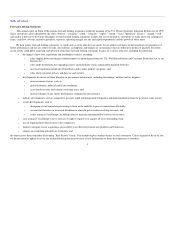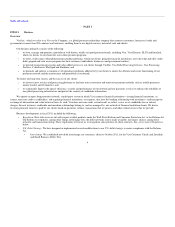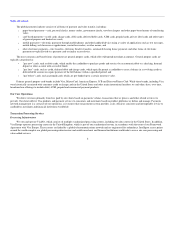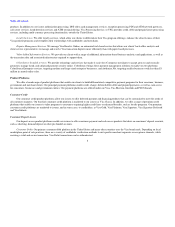Visa 2011 Annual Report Download - page 14
Download and view the complete annual report
Please find page 14 of the 2011 Visa annual report below. You can navigate through the pages in the report by either clicking on the pages listed below, or by using the keyword search tool below to find specific information within the annual report.
Table of Contents
Security Standards (PCI DSS). There has been significant progress in growing industry adoption of PCI DSS, with more than 97% percent of the largest U.S.
merchants validating compliance annually.
Government Regulation
General. Government regulation affects key aspects of our business. Our clients are also subject to numerous regulations applicable to banks and other
financial institutions in the United States and elsewhere, and consequently such regulations have the potential to affect our business indirectly. In recent years,
our business has come under increasing regulatory scrutiny. See Item 1A—Risk Factors—Increased global regulatory focus on the payments industry may
result in costly new compliance burdens on our clients and on us, leading to increased costs and decreased payments volume and revenues.
The Reform Act. As noted, during the 2011 fiscal year, the U.S. Federal Reserve established new rules under the Reform Act affecting interchange
reimbursement fees, network exclusivity and transaction routing. We expect these rules to have an adverse impact on our pricing, reduce the number and
volume of U.S. debit payments we process and decrease associated revenues. See Item 1—Management's Discussion and Analysis of Financial Condition and
Results of Operations—Overview and Item 1A—Risk Factors—The Reform Act may have a material, adverse effect on our financial condition, revenues,
results of operations, prospects for future growth and overall business. We have significantly modified our debit strategy as a result. See —Overview.
Interchange Reimbursement Fees. We have historically set default interchange reimbursement fees in the United States and many other geographies.
The new rules under the Reform Act set the maximum U.S. debit interchange reimbursement fee assessed for cards issued by large financial institutions at
twenty-one cents plus five basis points, before applying an interim fraud adjustment up to an additional one cent. This amounts to a significant reduction from
the average system-wide fees charged previously. See Item 1A—Risk Factors—The Reform Act may have a material adverse effect on our financial condition,
revenues, results of operations, prospects for future growth and overall business; Item 1A—Risk Factors—Increasing regulation of interchange
reimbursement fees and other business practices may have a material adverse impact on our financial condition, revenues, results of operations, prospects for
future growth and overall business, and Item 8—Financial Statements and Supplementary Data—Note 21—Legal Matters elsewhere in this report.
The United States is not the only jurisdiction to regulate interchange reimbursement fees. For example, the Reserve Bank of Australia has enacted a
regulation limiting the costs that can be considered in setting interchange reimbursement fees for both our credit and our debit cards.
Interchange reimbursement fees represent a transfer of value among the financial institutions participating in an open-loop payments network such as
ours. On purchase transactions, interchange reimbursement fees are paid to issuers by acquirers in connection with transactions initiated from products in our
payments system. We generally do not receive any portion of interchange reimbursement fees in a transaction. They are, however, a factor on which we
compete with other payments providers and are therefore an important determinant of the volume of transactions we process.
Default interchange reimbursement fees are an important driver of system volume and value. They promote the efficient operation of our payments
network by enabling both the issuer and the acquirer to understand the economics of a given transaction before entering into it and by giving our clients an
alternative to negotiating transfer pricing with each other. By establishing and modifying default interchange rates in response to marketplace conditions and
strategic demands, we seek to ensure a competitive value proposition for transactions using our cards in order to encourage electronic
13
























